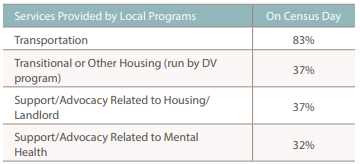Crisis Hotline: 706.571.6010

WHAT IS DOMESTIC VIOLENCE?
Domestic violence is the willful intimidation, physical assault, battery, sexual assault, and/or other abusive behavior as part of a systematic pattern of power and control perpetrated by one intimate partner against another. It includes physical violence, sexual violence, threats, and emotional abuse. The frequency and severity of domestic violence can vary dramatically.
National Coalition Against Domestic Violence (NCADV)
HOPE HARBOUR
Hope Harbour (local domestic violence shelter) Crisis Hotline: 706.324.3850
For more information about Hope Harbour: info@hopeharbour.org or visit www.hopeharbour.org
Georgia Coalition Against Domestic Violence (GCADV) 24-Hour Statewide Hotline:
1.800.33.HAVEN (1.800.334.2836)
The National Domestic Violence Hotline: 1.800.799.SAFE (7233)

GEORGIA STATISTICS
Statistics listed below are from the NCADV
STATISTICS FROM THE NATIONAL NETWORK TO END DOMESTIC VIOLENCE (NNEDV)
On September 13, 2017, 41 out of 51 (80%) identified domestic violence programs in Georgia participated in the National Census of Domestic Violence Services. The following figures represent the information reported by these 41 participating programs about services provided during the 24-hour survey period.
1,937 VICTIMS SERVED IN ONE DAY
1,136 adult and child victims of domestic violence found refuge in emergency shelters or transitional housing provided by local domestic violence programs. 801 adult and child victims received non-residential assistance and services, including counseling, legal advocacy, and children’s support groups.
450 HOTLINE CALLS ANSWERED
Domestic violence hotlines are a lifeline for victims in danger, providing support, information, safety planning, and resources. During the 24-hour survey period, local and state hotline staff in Georgia answered on average 19 hotline calls per hour.
206 UNMET REQUESTS FOR SERVICES IN ONE DAY, OF WHICH 79% (163) WERE FOR HOUSING
Victims made nearly 210 requests for services— including emergency shelter, housing, transportation, childcare, legal representation, and more—that could not be provided because programs lacked the resources to meet victims’ needs. In the past year, 11 local programs in Georgia laid off or did not fill 28 staff positions. Most of these positions (62%) were direct service providers, such as shelter staff or legal advocates. This means that there were fewer advocates to answer calls for help or provide needed services.

THE GCADV
FATALITY REVIEW PROJECT (2018)
In-depth reviews of domestic violence-related fatalities and near fatalities have proven to be a useful tool for generating important conversations and shedding light on the problem of domestic violence. This report is a summary of 15 years of work by the Georgia Domestic Violence Fatality Review Project (“the Project”) and provides an overview of all we have learned, both in Georgia and nationally, about gaps in the systemic response to domestic violence and the circumstances which surround deaths which have occurred as a result of relationship violence.
The Project, in its current incarnation, will come to a close December 31, 2018. The Project’s 14 previous Annual Reports, published between 2004–2017, have detailed the problems raised in case reviews, provided data and trends, and given voice to victims who lost their lives in our state. This Annual Report is the final Georgia Domestic Violence Fatality Review Annual Report and serves as a capstone for all previous reports. This report seeks to both encapsulate the important work done statewide in the past 15 years and to make recommendations for addressing the problem of domestic violence in Georgia moving forward.
STATISTICS FROM VIOLENCE POLICY CENTER ON MURDER-SUICIDE
MOST MURDER-SUICIDES INVOLVE AN INTIMATE-PARTNER:
The most prevalent type of murder-suicide was between two intimate partners, with a man killing his wife or girlfriend. Such events are commonly the result of a breakdown in the relationship. The average age difference between the offender and primary victim was 3.1 years. Overall, the age difference ranged from zero to 33 years. (Other studies on fatal violence for spouses have found that there is a greater risk of homicide victimization as the age difference between the husband and wife increases.) In this study, 65 percent of all murder-suicides involved an intimate partner. Of these, 96 percent were females killed by their intimate partners. Of these, 96 percent involved a gun.
MANY MURDER-SUICIDES WITH THREE OR MORE VICTIMS INVOLVE A MALE ”FAMILY ANNIHILATOR”—A SUBCATEGORY OF INTIMATE PARTNER MURDER-SUICIDE:
Many multiple-victim murder-suicides involving a male murderer and a large number of victims (three or more) are perpetrated by family annihilators. In this report, 55 percent (six of 11) of murder-suicides involving a male murderer and three or more victims were perpetrated by family annihilators. Family annihilators are murderers who kill their intimate partners and children, as well as other family members, before killing themselves. In many cases, a family annihilator is suffering from depression and has financial or other problems and feels the family is better off dying with him than remaining alive to deal with the problems at hand.
REFERENCES
1. http://www.thehotline.org/resources/statistics/
2. Black, M.C., Basile, K.C., Breiding, M.J., Smith, S.G., Walters, M.L., Merrick, M.T., Chen, J., & Stevens, M. (2011). The national intimate partner and sexual violence survey: 2010 summary report. Retrieved from http://www.cdc.gov/violenceprevention/pdf/nisvs_report2010-a.pdf
3. National Network to End Domestic Violence (2015). 2014 domestic violence counts: A 24-hour census of domestic violence shelters and services. Retrieved from http://nnedv.org/downloads/Census/DVCounts2014/DVCounts14_NatlSummary_Color-2.pdf
4. Truman, J. & Morgan, R. (2014). Nonfatal domestic violence, 2003-2012. Retrieved from http://www.bjs.gov/content/pub/pdf/ndv0312.pdf
5. Campbell, J.C., Webster, D., Koziol-McLain, J., Block, C., Campbell, D., Curry, M. A., Gary, F., Glass, N., McFarlane, J., Sachs, C., Sharps, P., Ulrich, Y., Wilt, S., Manganello, J., Xu, X., Schollenberger, J., Frye, V., & Lauphon, K. (2003). Risk factors for femicide in abusive relationships: Results from a multisite case control study. American Journal of Public Health, 93(7), 1089-1097
6. Violence Policy Center. (2012). American roulette: Murder-suicide in the United States. Retrieved from www.vpc.org/studies/amroul2012.pdf





.png)






